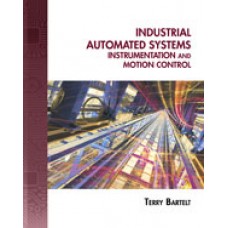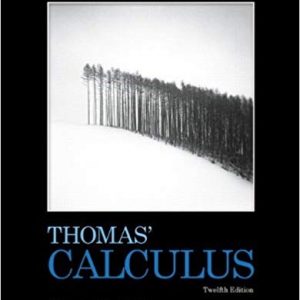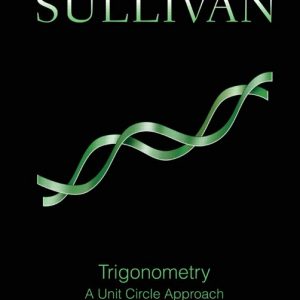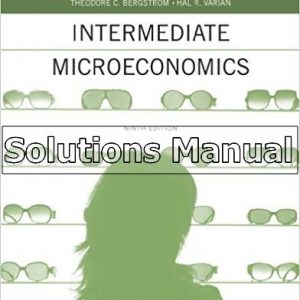This is completed downloadable of Solution Manual for Industrial Automated Systems Instrumentation and Motion Control, 1st Edition

Product Details:
- ISBN-10 : 1435488881
- ISBN-13 : 978-1435488885
- Author:
INDUSTRIAL AUTOMATED SYSTEMS: INSTRUMENTATION AND MOTION CONTROL, will provide readers with state-of-the art coverage of the full spectrum of industrial maintenance and control, from servomechanisms to instrumentation. They will learn about components, circuits, instruments, control techniques, calibration, tuning and programming associated with industrial automated systems. INDUSTRIAL AUTOMATED SYSTEMS: INSTRUMENTATION AND MOTION CONTROL, focuses on operation, rather than mathematical design concepts. It is formatted into sections so that it can be used to learn a variety of subjects, such as electrical motors, sensors, variable speed drives, programmable logic controllers, servomechanisms, and various instrumentation and process. This book also offers readers a broader coverage of industrial maintenance and automation information than other books and provides them with an extensive collection of supplements, including a lab manual and two hundred animated multimedia lessons on CD.
Table of Content:
- Section 1: Industrial Control Overview
- Ch 1: Introduction to Industrial Control Systems
- Introduction
- 1-1 Industrial Control Classifications
- 1-2 Elements of Open- and Closed-Loop Systems
- 1-3 Feedback Control
- 1-4 Practical Feedback Application
- 1-5 Dynamic Response of a Closed-Loop System
- 1-6 Feed-Forward Control
- Problems
- Ch 2: Interfacing Devices
- Introduction
- 2-1 Fundamental Operational Amplifiers
- 2-2 Signal Processors
- 2-3 Comparator Devices
- 2-4 Optoelectronic Interface Devices
- 2-5 Digital-to-Analog Converters
- 2-6 Analog-to-Digital Converters
- 2-7 Timing Devices
- Problems
- Ch 3: Thyristors
- Introduction
- 3-1 Silicon-Controlled Rectifiers
- 3-2 Unijunction Transistors
- 3-3 Diac
- 3-4 Triac
- 3-5 IGBTs
- Problems
- Section 2: The Controller
- Ch 4: The Controller Operation
- Introduction
- 4-1 Control Modes
- 4-2 On-Off Control
- 4-3 Proportional Control
- 4-4 Proportional-Integral Control
- 4-5 Proportional-Integral-Derivative Control
- 4-6 Time-Proportioning Control
- 4-7 Time-Proportioning Circuit
- Problems
- Section 3: Electric Motors
- Ch 5: DC Motors
- Introduction
- 5-1 Principles of Operation
- 5-2 Rotary Motion
- 5-3 Practical DC Motors
- 5-4 Control of Field Flux
- 5-5 Counterelectromotive Force
- 5-6 Armature Reaction
- 5-7 Motor Selection
- 5-8 Interrelationships
- 5-9 Basic Motor Construction
- 5-10 Motor Classifications
- 5-11 Coil Terminal Identification
- Problems
- Ch 6: AC Motors
- Introduction
- 6-1 Fundamental Operation
- 6-2 Stator Construction and Operation
- 6-3 Types of AC Motors
- 6-4 Single-Phase Induction Motors
- 6-5 Resistance-Start Induction-Run Motor
- 6-6 Capacitor-Start Induction-Run Motor
- 6-7 Shaded-Pole Motor
- 6-8 Troubleshooting Split-Phase AC Motors
- 6-9 Universal Motors
- 6-10 Three-Phase Motors
- 6-11 Induction Motor
- 6-12 Wound-Rotor Motor
- 6-13 Synchronous Motor
- 6-14 Motor Nameplate
- Problems
- Ch 7: Servo Motors
- Introduction
- 7-1 DC Servo Motors
- 7-2 Wound Armature PM Motor
- 7-3 Moving Coil Motor
- 7-4 Brushless DC Motors
- 7-5 Stepper Motors
- 7-6 Permanent Magnet Stepper Motor
- 7-7 Variable Reluctance Stepper Motor
- 7-8 AC Servo Motors
- Problems
- Section 4: Variable-Speed Drives
- Ch 8: DC Drives
- Introduction
- 8-1 DC Drive Fundamentals
- 8-2 Variable-Voltage DC Drive
- 8-3 Motor Braking
- Problems
- Ch 9: AC Drives
- Introduction
- 9-1 AC Drive Fundamentals
- 9-2 AC Drive System
- 9-3 Drive Controller Internal Circuitry
- 9-4 Circuit Operation of the AC Drive
- 9-5 Flux Vector Control
- 9-6 PWM Control Methods
- 9-7 Control Panel Inputs and Drive Functions
- 9-8 Inverter Self-Protection Function
- 9-9 Motor Braking
- 9-10 Four-Quadrant Operation of AC Motors
- 9-11 AC Drive Selection
- 9-12 Motors Driven by AC Drives
- Problems
- Section 5: Process Control and Instrumentation
- Ch 10: Pressure Systems
- Introduction
- 10-1 Pressure Laws
- 10-2 Properties of a Liquid
- 10-3 Properties of a Gas
- 10-4 Pressure Measurement Scales
- 10-5 Pressure Measurement Instruments
- 10-6 Nonelectrical Pressure Sensors
- 10-7 Electronic Pressure Sensors
- 10-8 Pressure Control Systems
- Problems
- Ch 11: Temperature Control
- Introduction
- 11-1 Fundamentals of Temperature
- 11-2 Thermal Control Systems
- 11-3 Thermodynamic Transfer
- 11-4 Thermal Energy Source
- 11-5 Temperature Measurements
- 11-6 Temperature-Indicating Devices
- 11-7 Electronic Sensors
- Problems
- Ch 12: Flow Control
- Introduction
- 12-1 Systems Concepts
- 12-2 Flow Units of Measurement
- 12-3 Solid Flow Measurement
- 12-4 Fluid Flow Measurement
- 12-5 Electronic Sensors
- 12-6 Flowmeter Placement
- 12-7 Selecting a Flowmeter
- Problems
- Ch 13: Level-Control Systems
- Introduction
- 13-1 A Level-Control System
- 13-2 Methods of Measurement
- 13-3 Level-Measurement Methods
- 13-4 Electronic Sensors
- 13-5 Selecting a Level Sensor
- Problems
- Ch 14: Analytical Instrumentation
- Introduction
- 14-1 pH Measurement and Control
- 14-2 Conductivity
- 14-3 Combustion Analyzers and Control
- 14-4 Humidity
- 14-5 Sampling Measurement System
- Problems
- Ch 15: Industrial Process Techniques and Instrumentation
- Introduction
- 15-1 Batch Processes
- 15-2 Continuous Processes
- 15-3 Instrumentation
- 15-4 Measurement Devices (Sensors)
- 15-5 Feedback Loop Interface Instruments
- 15-6 Controllers
- 15-7 Monitoring Instruments
- 15-8 Manipulation Devices (The Final Control Element)
- Problems
- Ch 16: Instrumentation Symbology
- Introduction
- 16-1 General Instrument Symbols
- 16-2 Tag Numbers
- 16-3 Line Symbols
- 16-4 Valve and Actuator Symbols
- 16-5 Reading a Single Loop
- 16-6 Information Block
- Problems
- Ch 17: Process-Control Methods
- Introduction
- 17-1 Open-Loop Control
- 17-2 Closed-Loop Control
- 17-3 Single-Variable Control Loop
- 17-4 Selecting a Controller
- 17-5 On-Off Control
- 17-6 Continuous Control
- 17-7 Advanced Control Techniques
- Problems
- Ch 18: Instrument Calibration and Controller Tuning
- Introduction
- 18-1 Instrument Calibration
- 18-2 Reasons for Performing Calibrations
- 18-3 Calibration Preparation
- 18-4 Standard Calibration Procedure
- 18-5 Five-Point Calibration Procedure
- 18-6 Process Calibrators
- 18-7 Tuning the Controller
- 18-8 Trial-and-Error Tuning Method
- 18-9 Ziegler-Nichols Continuous-Cycling Method
- 18-10 Ziegler-Nichols Reaction-Curve Tuning Method
- 18-11 Controller Autotuning
- Problems
- Section 6: Detection Sensors
- Ch 19: Industrial Detection Sensors and Interfacing
- Introduction
- 19-1 Limit Switches
- 19-2 Proximity Detectors
- 19-3 Inductive Proximity Switches
- 19-4 Capacitive Proximity Switches
- 19-5 Hall-Effect Sensor
- 19-6 Photoelectric Sensors
- 19-7 Methods of Detection
- 19-8 Photoelectric Sensor Adjustable Controls
- 19-9 Photoelectric Package Styles
- 19-10 Operating Specifications
- 19-11 Ultrasonic Sensors
- 19-12 Sensor Interfacing
- Problems
- Ch 20: Industrial Wireless Technologies
- Introduction
- 20-1 Wireless Architecture
- 20-2 Wireless Signals
- 20-3 Wireless Topologies
- 20-4 Self-Organizing Networks
- 20-5 Wireless Technologies
- 20-6 Radio Frequencies
- 20-7 Characteristics of the Radio Path
- 20-8 Power Management of Field Devices
- 20-9 Security
- 20-10 Wireless Standards
- Problems
- Section 7: Programmable Controllers
- Ch 21: Introduction to Programmable Controllers
- Introduction to PLC Functions
- 21-1 Industrial Motor Control Circuits
- 21-2 Relay Ladder Logic Circuits
- 21-3 Building a Ladder Diagram
- 21-4 Motor Starter Control Circuits
- Introduction to PLC Components
- 21-5 Rack Assembly
- 21-6 Power Supply
- 21-7 PLC Programming Units
- 21-8 Input/Output Sections
- 21-9 Processor Unit
- 21-10 Addressing
- 21-11 Relationship of Data File Addresses to I/O Modules
- Problems
- Ch 22: Fundamental PLC Programming
- Introduction
- 22-1 PLC Program Execution
- 22-2 Ladder Diagram Programming Language
- 22-3 Ladder Diagram Programming
- 22-4 Relay Logic Instructions
- 22-5 Timer Instructions
- 22-6 Counter Instructions
- 22-7 Data-Manipulation Instructions
- 22-8 Arithmetic Operations
- 22-9 Writing a Program
- Problems
- Ch 23: Advanced Programming, PLC Interfacing, and Troubleshooting
- Introduction
- 23-1 Jump Commands
- 23-2 Data Manipulation
- Programmable Controller Interfacing
- 23-3 Discrete Input/Output Modules
- 23-4 Troubleshooting I/O Interfaces
- 23-5 Analog Input and Output Signals
- 23-6 Special-Purpose Modules
- 23-7 Troubleshooting Programmable Controllers
- Problems
- Section 8: Motion Control
- Ch 24: Elements of Motion Control
- Introduction
- 24-1 Open-Loop and Closed-Loop Servo Systems
- 24-2 Motion-Control Parameters
- 24-3 Motion-Control Elements
- 24-4 Terminology
- 24-5 Operator Interface Block
- 24-6 Controller Block
- 24-7 Amplifier Block
- 24-8 Actuator Block
- 24-9 Feedback Transducer Block
- Problems
- Ch 25: Motion-Control Feedback Devices
- Introduction
- 25-1 Angular Velocity Feedback Devices
- 25-2 Angular Displacement Feedback Devices
- 25-3 Linear Displacement Feedback Devices
- Problems
- Ch 26: Fundamentals of Servomechanisms
- Introduction
- 26-1 Closed-Loop Velocity Servo
- 26-2 Bang-Bang Position Servo
- 26-3 Proportional Position Servomechanisms
- 26-4 Digital Position Control
- 26-5 Characteristics of a Servomechanism
- 26-6 Designing a Position Servo
- 26-7 Digital Controller
- 26-8 Tuning a Servomechanism
- 26-9 Master-Slave Servosystem
- Problems
- Section 9: Industrial Networking
- Ch 27: Industrial Networking
- 27-1 Introduction
- 27-2 Hierarchy of Industrial Networks
- 27-3 Network Topologies
- 27-4 Data Flow Management
- 27-5 Transmission Hardware
- 27-6 Network Backbones
- 27-7 Network Communication Standards
- 27-8 Fieldbus Networks
- Problems
- Answers to Odd-Numbered Problems
- Glossary
- Index





